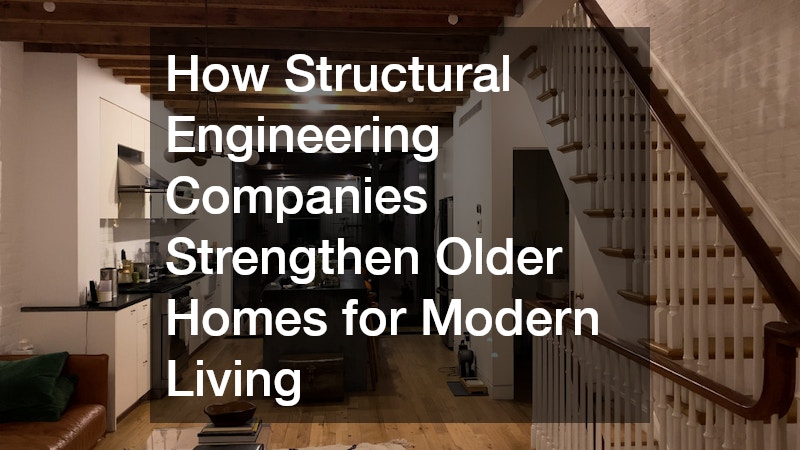Homeowners often dream of creating the ideal space—one that reflects their style, meets their needs, and adds long-term value. Planning refurbishment upgrades for your home isn’t simply about freshening up your walls or replacing old fixtures. It’s a strategic endeavor that blends aesthetics, functionality, safety, and investment value. From foundational repairs to curb appeal improvements, every step must be mapped out with care.
Refurbishment services can include anything from cosmetic changes like new flooring and paint to structural upgrades like foundation repairs or HVAC updates. Without a clear plan, homeowners may find themselves overwhelmed by the number of decisions and unforeseen complications that can arise. The first step in any successful home improvement journey is to assess the current condition of your property and prioritize your goals based on necessity and budget.
This blog will guide you through each phase of the planning process, providing tips and insights for making informed decisions. Whether you’re preparing to sell your home or want to enhance your living space for years to come, understanding how to use refurbishment services effectively can save you time, money, and stress. Let’s explore how you can approach this journey with clarity and confidence.
Start with a Full Property Inspection
Before embarking on any significant home improvement, it’s vital to know exactly what you’re working with. A professional inspection can reveal underlying issues that might not be visible to the untrained eye. Partnering with home inspection companies can help you get a detailed evaluation of your property’s condition. These professionals assess everything from electrical wiring and plumbing to structural integrity and insulation efficiency.
Understanding the findings from an inspection allows you to prioritize urgent repairs over aesthetic changes. For instance, if there’s evidence of mold, outdated wiring, or roof leaks, these must be addressed before investing in cosmetic enhancements. Skipping this step could lead to hidden costs later, derailing your entire refurbishment budget.
Home inspection companies provide reports that serve as roadmaps for refurbishment planning. They categorize issues based on severity, helping homeowners allocate funds appropriately. This also supports future interactions with contractors, ensuring the scope of work aligns with the property’s actual needs.
Incorporating refurbishment services early in the process ensures all improvements are built on a sound structure. The peace of mind gained through a comprehensive inspection is invaluable—it enables you to proceed with confidence, knowing your home can safely support the planned upgrades.
Evaluate Your Roofing System

Your roof is one of the most important components of your home’s exterior. It protects your interior spaces from weather damage and contributes significantly to energy efficiency. Before scheduling any internal upgrades, it’s essential to evaluate the condition of your roof. Roofing contractors can help determine if a repair, patch, or complete replacement is required.
Signs such as missing shingles, water stains on ceilings, or increasing energy bills may indicate that your roof is no longer functioning optimally. Refurbishment services that include roofing assessments can prevent costly damage to your attic, walls, and insulation. Neglecting your roof during a home upgrade project may undermine all other improvements.
Working with roofing contractors ensures that materials used for upgrades are durable and weather-resistant. This phase of your planning also offers the opportunity to consider installing energy-efficient shingles or adding insulation layers that reduce heat loss.
Addressing roofing issues before beginning interior renovations not only safeguards your investment but also enhances your home’s overall curb appeal and resale value. When your home’s topmost layer is solid and efficient, every other layer of the refurbishment plan has a stronger foundation to succeed.
Incorporate Structural Enhancements
Beyond surface-level improvements, structural upgrades offer long-lasting benefits. If you’re considering building out or adjusting floor plans, you’ll want to coordinate with local home builders who understand regional zoning laws, permitting requirements, and environmental factors. These professionals can help turn your ideas into safe, functional additions.
Adding square footage or knocking down walls requires in-depth knowledge of load-bearing structures, wiring placement, and utility access. This is where refurbishment services truly shine—bringing together designers, engineers, and skilled tradespeople to deliver cohesive solutions. Local home builders can help streamline this process by coordinating with subcontractors and ensuring all phases of construction comply with regulations.
Even if you’re not expanding, structural improvements like reinforcing beams or installing updated framing may be necessary. These updates can enhance the safety of your home, increase its market value, and prepare it for future projects such as smart home integrations or solar panel installations.
Collaborating with professionals who understand both aesthetics and engineering ensures your refurbishment journey goes beyond surface enhancements. Structural integrity is the backbone of any home, and getting it right allows all other upgrades to function efficiently and safely for the long haul.
Understand Your Property’s Market Value

One of the smartest things homeowners can do during the planning phase is assess how their investments will impact property value. A home appraisal company provides this crucial perspective by evaluating your home’s current market worth and estimating how certain upgrades may influence resale potential.
Appraisers look at multiple aspects of your property, including square footage, lot size, neighborhood, and recent sales in the area. When planning refurbishment services, understanding these numbers can help you decide where to invest your money. For example, adding a luxury kitchen in a mid-range neighborhood might not yield the return on investment you expect.
Moreover, home appraisal professionals can offer insight into which upgrades are in high demand. This helps homeowners prioritize features that appeal to buyers, such as energy-efficient windows, updated bathrooms, or smart home systems.
Collaborating with a home appraisal company ensures your refurbishment plan aligns with both personal comfort and market logic. You’ll gain a clearer picture of how each improvement contributes to your home’s overall value—and more importantly, you’ll avoid overspending on features that don’t provide a solid return.
Address Any Foundation Issues
One of the most critical, yet often overlooked, aspects of home refurbishment is the foundation. Before cosmetic upgrades or additions can be made, it’s crucial to ensure the base of your home is structurally sound. A foundation repair company can inspect for common issues such as cracks, moisture intrusion, or uneven settling.
Foundation issues can cause a domino effect throughout your home, leading to misaligned doors, sagging floors, and even plumbing problems. Addressing these problems early in your refurbishment services plan avoids compounding costs and ensures all other improvements have a strong base to rely on.
These repairs may involve waterproofing, pier installation, or soil stabilization. While they may not be as visually satisfying as a bathroom remodel or a new kitchen, they’re among the most impactful long-term investments. A compromised foundation undermines even the best renovations, making structural integrity a priority.
Consulting with a foundation repair company helps determine the scope of necessary work and its timeline. Factoring this into your budget ensures your home remains stable and valuable for decades to come. Never underestimate the importance of beginning your refurbishment from the ground up—literally.
Upgrade Entry Points and Exterior Hardware
As you think about improving your home’s appearance and security, consider investing in modernizing your garage door. This often-overlooked feature has a surprising impact on curb appeal and energy efficiency. New models come with insulated panels, smart openers, and reinforced locks, making them both functional and stylish.
A fresh garage door can completely change your home’s façade. Many homeowners are surprised to learn that this upgrade often has one of the highest returns on investment. When paired with other refurbishment services, it also helps create a cohesive, updated aesthetic for your property’s exterior.
In addition to enhancing security, modern garage doors can reduce drafts and noise, leading to greater comfort indoors. It’s also worth considering a design that complements your home’s architecture and color scheme for a polished look.
Entry points like garage doors are part of your home’s first impression. Making them durable, attractive, and efficient is essential to a successful refurbishment plan. This simple yet strategic improvement provides visual and functional benefits that tie your entire renovation together.
Don’t Neglect Heating System Upkeep

While planning your home refurbishment, make time to assess your heating system. A reliable furnace ensures comfort and can significantly affect your energy bills. Scheduling furnace maintenance as part of your overall plan ensures your HVAC system is running efficiently before colder months hit.
Neglecting routine furnace maintenance can lead to breakdowns when you least expect it. Dust buildup, filter clogs, and worn-out parts can reduce the efficiency of your system and create safety hazards like carbon monoxide leaks. Refurbishment often incorporates HVAC checks into broader home improvement projects to ensure seamless functionality.
A well-maintained furnace contributes to indoor air quality and lowers utility costs—important considerations in any home upgrade. This is also a good opportunity to evaluate whether your current heating system meets modern energy standards or if it’s time for an upgrade.
Including furnace maintenance in your planning ensures your home remains cozy and efficient, even as you work on aesthetic improvements. It’s a small yet crucial step in achieving a well-rounded, functional living space.
Fix or Replace Garage Mechanisms
If your garages door is outdated or malfunctioning, a proper garage door repair should be high on your refurbishment checklist. Beyond aesthetics, a malfunctioning door poses safety risks and may compromise your home’s security.
Over time, wear and tear on components such as springs, cables, and tracks can render your door unreliable. A qualified technician can assess whether a repair will suffice or if a full replacement is necessary. Including this as part of your refurbishment plan ensures every entry point to your home is safe and functional.
Additionally, many garage doors now feature smart technology, allowing for remote access and integration with home security systems. If you’re investing in other smart home features, a modern door system can help tie everything together.
While it may seem like a small detail, functional door repair adds to your home’s overall efficiency and aesthetic harmony. Don’t overlook this essential upgrade—it plays a vital role in the safety and value of your property.
Prioritize Air Conditioning Efficiency

With climate control becoming increasingly important, evaluating your air conditioning system should be a central part of your upgrade strategy. Whether it’s routine maintenance or necessary AC repairs, ensuring your HVAC system works efficiently supports your overall comfort and energy savings.
Older systems tend to consume more energy and struggle to maintain consistent indoor temperatures. Refurbishment services often recommend upgrades to programmable thermostats, energy-efficient units, or zoned cooling systems. These modern solutions not only improve comfort but also contribute to sustainability goals.
Prompt AC repairs can prevent more significant problems down the road. Simple issues like refrigerant leaks or clogged filters can quickly escalate if ignored. Making these corrections during your refurbishment phase avoids disruptions later and aligns your living space with modern efficiency standards.
Your HVAC system plays a huge role in your daily life, impacting everything from sleep quality to indoor air cleanliness. Make sure it’s included in your refurbishment plan to ensure long-term performance and comfort throughout your home.
Enhance Water Flow and Drainage
Proper water management protects your home from structural damage, mold growth, and soil erosion. One of the simplest and most effective ways to support good drainage is with a professional gutter installation. This step often gets overlooked but is vital during any major home upgrade.
Old or inefficient gutters may leak, clog, or pull away from the roof, causing water to accumulate around the foundation. This can compromise structural integrity and undo other investments in refurbishment. Modern gutter systems are designed to be low-maintenance, with features like leaf guards and corrosion-resistant materials.
Installing new gutters not only protects your home but can also contribute to its appearance. Many contemporary gutter systems are sleek and color-coordinated with your roofing and siding, giving your home a cleaner look.
When planning your home upgrade, don’t forget about the top-down protection gutters provide. It’s a smart, affordable way to extend the life of your home and the value of your renovations. Well-planned gutter installation is one of the final touches that make your refurbishment project complete and successful.
Planning a successful home upgrade involves more than picking paint colors or installing new cabinets. It’s a comprehensive process that blends functionality, safety, design, and long-term value. Refurbishment services are the thread that ties it all together, offering coordinated solutions for every aspect of your home.
From partnering with a home inspection company to consulting with contractors, and from investing in AC to installing new gutters, every decision contributes to your home’s future resilience and comfort. Hiring the right professionals at each stage— home builders, home appraisal companies, and foundation experts—ensures your investment is sound and strategic.
Incorporating key upgrades like garage repairs, furnaces, and functional entryways further enhances your home’s value. These elements create a living environment that’s not only more beautiful but also safer and more energy-efficient.
Whether you’re prepping for resale or designing your forever home, a well-thought-out plan using refurbishment services will help you achieve your goals. Take the time to assess, prioritize, and invest wisely. With the right approach, your home transformation will be both rewarding and enduring.



